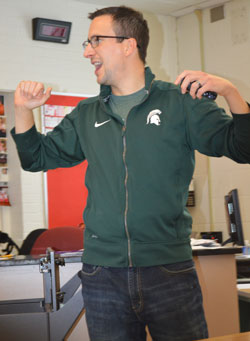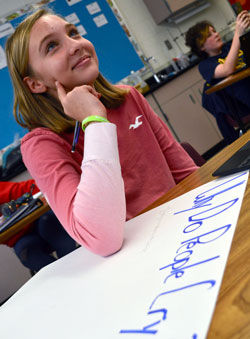Fridays in Jim Grulke’s seventh grade science classes this fall were a tinkerer’s paradise. That’s because Grulke, who teaches five sections of seventh grade science, dubbed the last day of the week “Figure It Out Fridays.”

Like why people cry. Or how to modify a lacrosse stick. Or how to make glitter that won’t harm the environment or humans.
“We just love the look of glitter and how pretty it is,” explained Rylei Weller, who worked with group members Emma Jenks, Grady Proctor and Johnny Pike to come up with a sugar and a salt-based product.
Their second effort, squirting food coloring on sugar and baking it, worked better after “someone thought to boil it, and that obviously didn’t work,” Rylei said. Once they came up with a method that stuck, their next task was to find out why baking seems to work.
The Why and the How
Students spent 12 weeks coming to their own conclusions about a nagging “why” or “how” question.

Similar to what some schools refer to as “genius hour,” Figure It Out Fridays were aimed at sparking curiosity and engagement. Grulke said he wanted to try out the activity ever since his wife, a former third grade teacher, shared with him about her own students’ engagement.
“It’s a way to foster creativity, especially in that time between the beginning of the year and Thanksgiving, which always feels like the longest stretch without a break,” he said.
“This is a way to keep them interested in learning about what they want to learn about.” Projects didn’t have to involve science, he said, because the aim was to grow students’ research and planning skills — definitely required in any science class.

Grulke wasn’t sure whether he will continue Figure It Out Fridays the rest of the year, but the pilot provided plenty of items for him to do more figuring, he said. Which, after all, is what research and development is all about.
“Most students really dug in right away but others seemed overwhelmed, so I need to give those students more guidance and support. I also need to know what they thought of it, because my perspective might be different from theirs.”
Braelyn Larson thought big and was pleased she stuck with her plan to start an after-school art club. With guidance from Grulke, she figured out where the club will meet, what supplies are needed, how to attract members and what activities to offer.
An added and possibly unanticipated bonus: connection. “The first week I’ll ask them to make something that tells me about you,” Braelyn said. “There’s some eighth graders who signed up I don’t know.”













